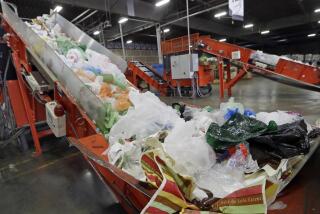an Oscar for Best Supporting Polymer?
- Share via
Long reviled for its formlessness and lack of biodegradability, the plastic bag is at last attaining respect. In the suburban satire “American Beauty,” it swells to bursting with the spirit of love as the star of a disaffected teenager’s sublime video. And last month, it held rapt an audience of several hundred at a Caltech lecture. The subject? “Grocery Bags to Baseball Bats: Polymers and Us.”
During the casting of “American Beauty,” Lucky and Vons bags were ruled out for being region-specific, says Lynda Reiss, the film’s prop master. “We were trying for broad strokes.” Awash in logos, she briefly faced the prospect of enormous environmental and monetary waste. “I did some research,” she says, “and to buy a plain white plastic bag, you’d have to order a thousand. Which is ridiculous.”
Finally, after trolling Pic ‘N Save and 99 Cents Only for other tchotchkes, Reiss and her assistant returned to her living room, miraculously clutching a bag from one of those stores--they’re not sure which--that was exactly what director Sam Mendes had in mind. The total unknown performed splendidly its mute aerial ballet amid dust and dull brick, kept aloft by off-camera leaf blowers.
Robert H. Grubbs, the Caltech professor and polymer expert who gave the “Grocery Bag” lecture, has yet to behold the bag in”American Beauty.” He and his associates have been otherwise engaged: “We’ve been meaning to see the film,” Grubbs says. “Our one day to go out last week, we saw ‘Lucie Aubrac.’ There’s no great polymers in that movie, but it’s a great movie.”
Although “American Beauty’s” best supporting polymer served as a touchstone for transcendent existence, it has not been enshrined. “Probably the bag just ended up in a trash bin,” Reiss says, “which is the saddest thing on earth.”
More to Read
Only good movies
Get the Indie Focus newsletter, Mark Olsen's weekly guide to the world of cinema.
You may occasionally receive promotional content from the Los Angeles Times.










